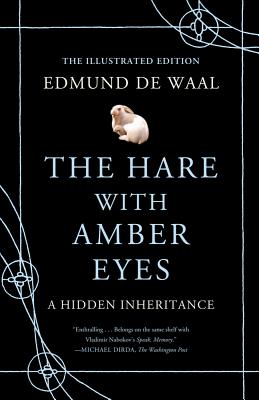The Hare with Amber Eyes by Edmund de Waal Published: 2012 Read from: 11 May to 31 May My rating: 🌟 🌟 🌟 🌟
A friend happened to meet Edmund de Waal at this year's Venice Biennale, and in telling us about the encounter he was so persuasive about this book, which had made him seek out de Waal, that I resolved to read it. I'm so glad I did. It had been sitting on the shelf here forever, and while I had been aware of it, I thought it was about netsuke. It is, and so much more.
The netsuke are important, of course they are, for they set de Waal off on this family history, and while they certainly turn up throughout the book and play various parts in the story, it is the story of the family that is the core of the book. The Ephrussi (or Efrussi) dynasty began in Odessa, on the shores of the Black Sea, as grain traders. Almost all the huge grain harvests of the Ukraine flowed through their warehouses, creating a fortune that grew into one of the great banking houses of Europe, underwriting every huge project. The Ephrussi were the equals of the Rothschilds, the two families naturally united in marriage, and like the Rothschilds were Jewish.
The netsuke were first collected by Charles Ephrussi in Paris, and de Waal does a great job of bringing to life the world of money and art in Paris in the 1870s. Charles then sends them as a wedding present to his cousin Viktor in Vienna, where de Waal pursues them to continue chronicling the life of his family (Viktor is his great grandfather).
The heart of the book, for me, which often made me put it down to stare off into the distance processing what I had just read, was the almost matter-of-fact way in which de Waal chronicles the events in Vienna after the anschluss and "aryanisation" robbed the Ephrussi not only of their worldly goods but also of their culture and history. Not the netsuke, obviously, though I won't spoil the story by explaining how.
Casual anti-semitism runs through the lives of the Ephrussi as it ran through the lives of all Jewish families, prominent and assimilated as much as those newly arrived from the East. Renoir, for example, while only too happy to sell his sweet little portaits to Charles Ephrussi, said of Gustave Moreau, another artist Charles fancied: “It was clever of him [Moreau] to take in the Jews, to have thought of painting with gold colours … even Ephrussi fell for it!” In civilised Vienna especially, the veneer of civilisation was thin indeed.
A couple of years ago I read East West Street: On the Origins of Genocide and Crimes Against Humanity by Phillipe Sands, though I didn't review it here or there, beyond giving it four stars. It is somewhat similar in that while it has something else at its core, it is also about Jewish families and their histories, open and hidden. I find this kind of book more enjoyable than straight history, maybe because I find it easier to be drawn along by the narrative, absorbing the background along the way. I suppose I am vicariously constructing a sort of family history for myself, a Jewish atheist, in lieu of one I don't have. Looking for recommendations.
And wearing my other, food and agriculture, hat, I'd also love to know more about the early days of the international grain trade.
Even if you're not interested in either of those, I can highly recommend The Hare with Amber Eyes.
Webmentions
Webmentions
Webmentions allow conversations across the web, based on a web standard. They are a powerful building block for the decentralized social web.
If you write something on your own site that links to this post, you can send me a Webmention by putting your post's URL in here:

Comments